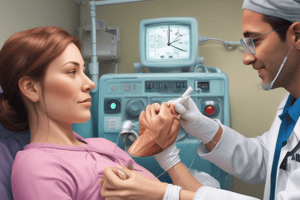Podcast
Questions and Answers
What is the most common cause of laryngospasm in children?
What is the most common cause of laryngospasm in children?
- Dust
- Tuberculosis
- Vitamin D deficiency (correct)
- Bronchial asthma
Which of the following is a characteristic of the clinical picture of laryngospasm?
Which of the following is a characteristic of the clinical picture of laryngospasm?
- Noisy, difficulty inspiratory breathing (correct)
- Chest pain
- Difficulty expiratory breathing
- Acrocyanosis
What is the recommended emergency care for bronchospasm?
What is the recommended emergency care for bronchospasm?
- Salbutamol (correct)
- Vikasol
- Vitamin C
- Analgin
Which stage of acute respiratory failure is characterized by hypercapnia?
Which stage of acute respiratory failure is characterized by hypercapnia?
What is the most common cause of pulmonary bleeding?
What is the most common cause of pulmonary bleeding?
Study Notes
Causes of Laryngospasm in Children
- Vitamin D deficiency
- Dust
- Irritation of the nerve larynx
- Bronchial asthma
- Tuberculosis
Clinical Picture of Laryngospasm
- Noisy, difficulty inspiratory breathing
- Expiratory dyspnea
- Fine wheezing
- Pathological bronchial breathing
- Rubbing noise of the pleura
Clinical Picture of Bronchospasm
- Difficulty expiratory breathing
- Acrocyanosis
- Chest pain
- Pathological bronchial breathing
- Rubbing noise of the pleura
Emergency Care for Bronchospasm
- Salbutamol
- Analgin
- Vitamin C
- Paracetamol
- Vikasol
Stages of Acute Respiratory Failure
- Compensation
- Hypercapnia
- Hypoxemia
- Hemic Circulatory
Causes of Pulmonary Bleeding
- Lungs' cancer
- Acute bronchitis
- Anemia
- Bronchial asthma
- Dermatitis
Clinical Picture of Pulmonary Hemorrhage
- Scarlet bleeding
- Coffee grounds
- Dyspnea
- Rubbing noise of the pleura
- Vesicular respiration
Emergency Care for Pulmonary Hemorrhage
- Aminocaproic acid
- Eufillin
Studying That Suits You
Use AI to generate personalized quizzes and flashcards to suit your learning preferences.
Description
Test your knowledge on the causes and clinical presentation of laryngospasm and bronchospasm in children, as well as emergency care procedures for bronchospasm. Questions cover topics such as vitamin D deficiency, dust irritation, bronchial asthma, noisy breathing, wheezing, and emergency medications.




